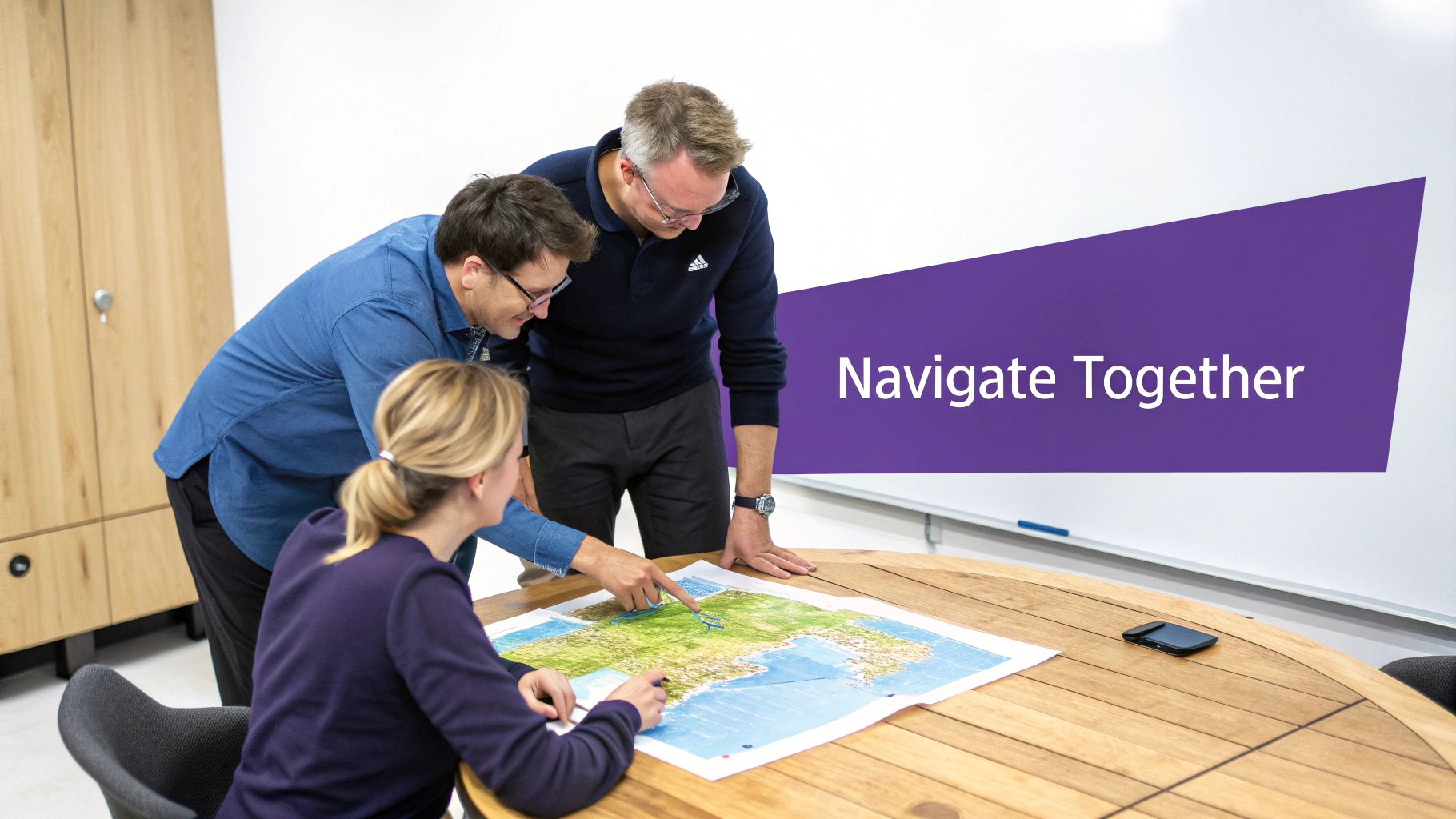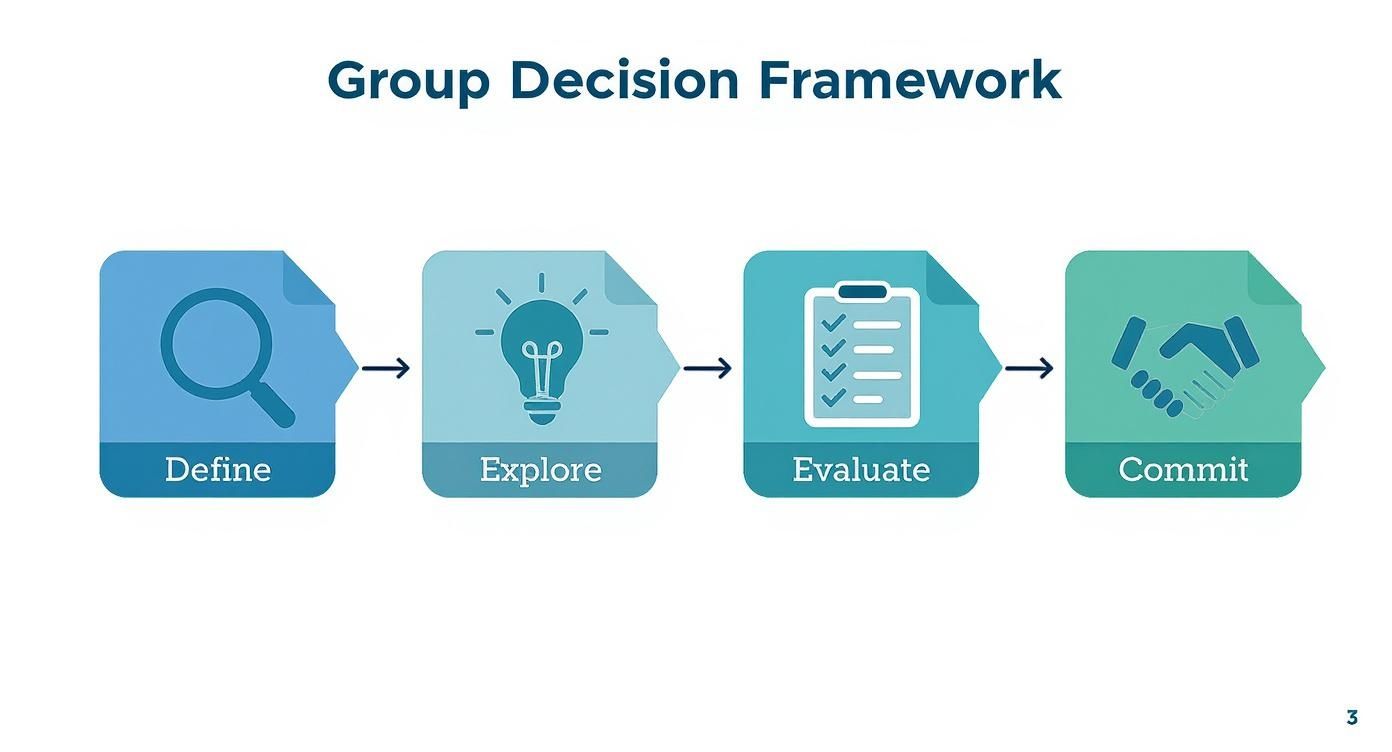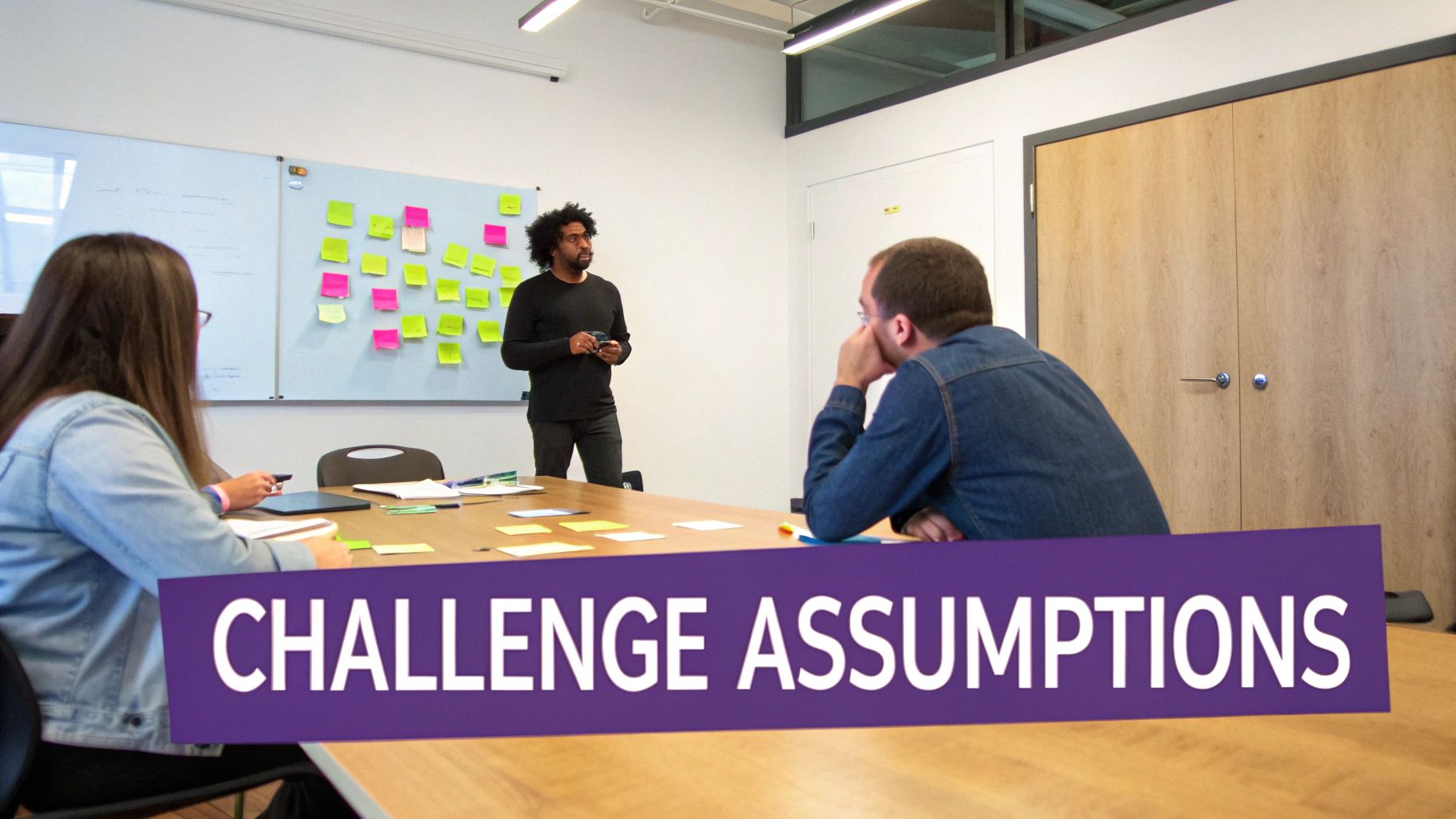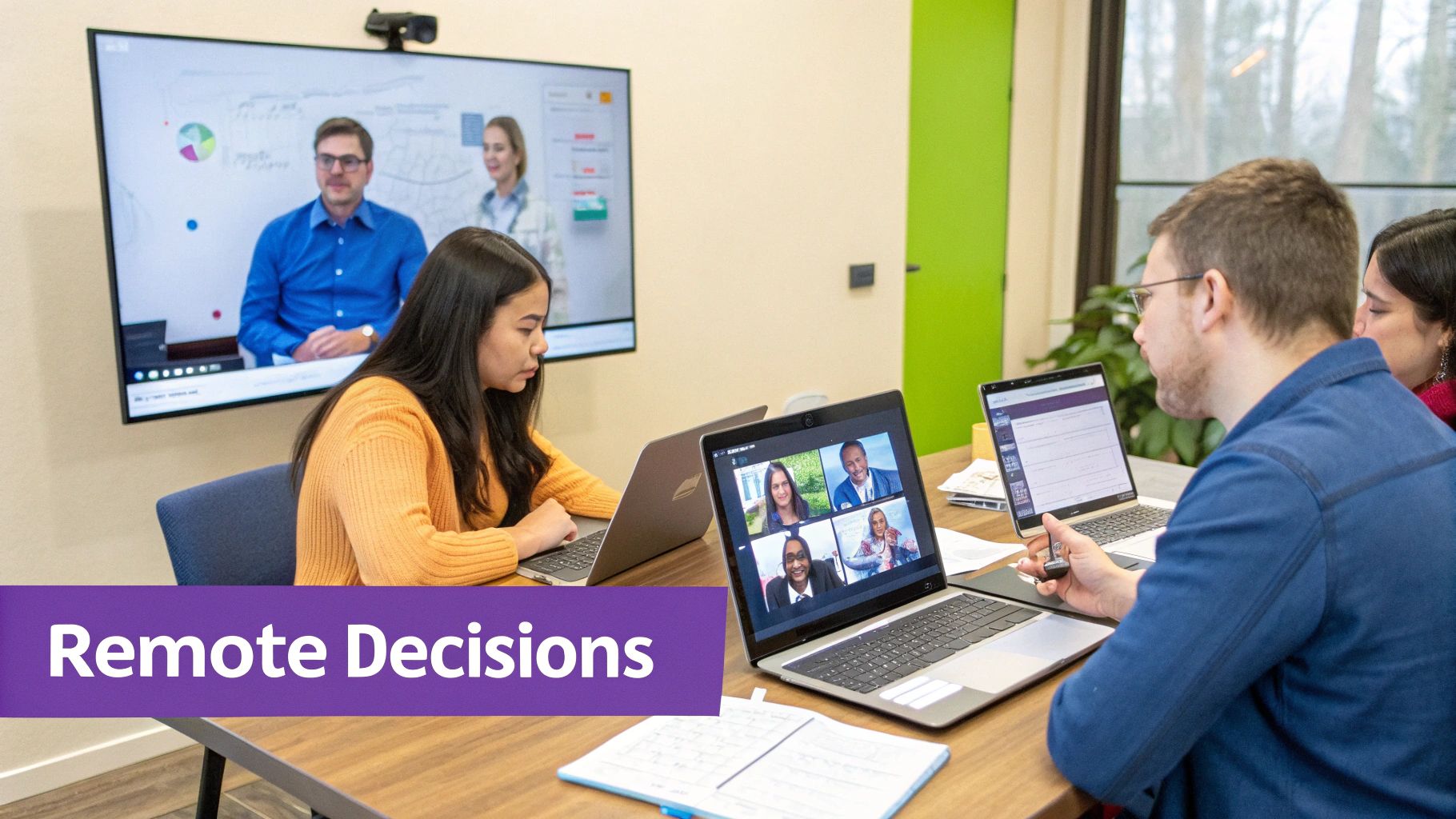Making a decision as a group is all about a bunch of people coming together to pick one option from a handful of choices. The whole point is to bring different perspectives into the mix to land on a better, more thoughtful outcome than any one person could dream up on their own.
Of course, it’s not always that simple. Without the right approach, group decisions can get messy, bogged down by conflict and wasted time.
The High Stakes of Group Decisions

Think of decision making in groups like steering a big ship. One person with a map might be quick, but they could easily overlook a hidden reef or miss a current that someone else might have noticed. With a full crew, you have more eyes on the water and a deeper pool of expertise.
But there’s a catch. While that collective brainpower can lead to a much safer voyage, it can also spiral into a chaotic debate. If everyone is grabbing for the wheel, the ship just ends up going in circles. This is the classic paradox of collaboration: the very diversity that sparks great ideas can also bring everything to a grinding halt.
The Challenge of Collective Choice
Today's business challenges are just too big for one person to solve alone. Whether you're launching a new product or overhauling a marketing plan, the best results almost always come from a healthy mix of different skills, experiences, and viewpoints.
Even so, the process can feel incredibly frustrating. Teams often run into the same old roadblocks:
- Analysis Paralysis: Everyone gets so caught up in debating the details that a decision is never actually made.
- Dominant Voices: One or two outspoken people can easily drown out quieter but equally valuable contributors.
- Lack of Clarity: Without a clear roadmap, conversations wander aimlessly and never reach a real conclusion.
And it’s only getting harder. A recent global survey found a rising tide of "decision distress." A staggering 74% of people feel the number of decisions they have to make each day has ballooned in the past few years. On top of that, 86% say the sheer volume of data makes the whole process more confusing, leading many to just give up.
Effective group decisions don't happen by accident. They're the result of a deliberate process, clear communication, and an awareness of the psychological traps that can derail even the sharpest teams.
Setting the Stage for Success
To keep your ship from getting lost at sea, you need a good map for the decision-making journey itself. A great first step is understanding who the key players are and how much influence they have. Our guide on what is stakeholder mapping can help you figure out who needs a seat at the table.
Ultimately, successful decision making in groups depends on a structured approach. It’s about creating a framework where all voices are heard, ideas are judged fairly, and everyone is committed to the final choice. By getting ahead of the common pitfalls, you can transform potential chaos into a powerful engine for progress.
A Simple Framework for Group Decisions
Jumping into a group decision without a plan is a lot like trying to cook a fancy meal without a recipe. You might have all the right ingredients—smart people, good intentions—but the result is often a mess. A structured framework is your recipe, turning what could be a chaotic discussion into a clear, step-by-step process for effective decision making in groups.
Think of this simple, four-stage model as a shared map for your team. It gets everyone on the same page, demystifying the process and making it feel manageable from start to finish.
Stage 1: Define the Problem
Here’s the single biggest reason group decisions fall apart: the team isn't actually trying to solve the same problem. One person thinks the issue is low sales, another is convinced it's poor marketing, and a third is pointing fingers at product features. Before you can even think about solutions, everyone has to agree on what the challenge really is.
This first stage is all about getting aligned. You need to ask some hard questions to get to the heart of the matter:
- What is the specific problem we are trying to solve?
- Why is it important that we solve it now?
- What does a successful outcome actually look like?
By clearly defining the problem and its scope, you're laying a solid foundation for everything that follows. This step stops the team from wasting time debating solutions to different, unspoken problems. It’s about agreeing on the destination before you start arguing about the best route to get there.
Stage 2: Explore Solutions
Once the problem is crystal clear, it’s time to shift gears into a more creative, exploratory phase. The goal here is simple: quantity over quality. This isn't the time to pick ideas apart or evaluate anything. It’s about getting as many potential solutions on the table as possible, no matter how wild they might seem at first.
Think of it as casting a wide net. Encourage brainstorming sessions, research, and open-ended discussions to gather a diverse pool of ideas. The key is to suspend all judgment so you don't shut down creative avenues before they even have a chance. Making informed group decisions depends on having access to collective information, a concept at the heart of strong knowledge management best practices.
A classic mistake is to mash exploration and evaluation together. When a team starts critiquing every idea as soon as it's shared, it kills creativity and makes people self-censor. Keep these stages strictly separate to build a space where every idea is welcome.
Stage 3: Evaluate Options
Now that you have a healthy list of potential solutions, the group can switch from a creative mindset to a critical one. This is where you systematically analyze each option against a set of criteria you’ve already agreed on. Those criteria should tie directly back to the problem you defined in the first stage.
For example, if the problem was "high customer churn," your evaluation criteria might look something like this:
- Impact: How much will this solution actually reduce churn?
- Cost: What are the real financial and resource requirements?
- Timeline: How quickly can we realistically implement this?
- Risk: What are the potential downsides or unintended consequences?
This kind of structured evaluation keeps the decision grounded in logic and evidence, not just emotion or personal bias. It helps the team compare options on a level playing field, which leads to a much more objective and defensible choice. For a closer look at the steps inside this process, check out our guide on the decision-making process steps.
Stage 4: Commit to Action
The final stage is where the decision gets real. It’s not enough to just pick an option. The group has to commit to a clear plan to make it happen. After all, a decision without an action plan is just a conversation that went nowhere.
This stage has two vital parts: making the final call and then outlining the very next steps. The team needs to assign ownership, set clear deadlines, and define how everyone will measure progress. This creates accountability and ensures that all the momentum you built in the discussion translates into real, tangible action.
By following this four-stage framework, your team can navigate the tricky terrain of decision making in groups with much more confidence and clarity. It turns a potentially frustrating chore into a powerful tool for working together successfully.
Choosing the Right Decision Making Model
Once your team is on the same page about how to get from problem to solution, the next big question is: who makes the final call? There’s no single "best" way to make decision making in groups work. The right tool always depends on the job.
Think about it—you wouldn't use a full consensus process to decide where to order lunch. That's overkill. On the other hand, you wouldn't want one person making an autocratic call on a major strategic shift for the company. It's all about matching the model to the moment.
Autocratic Decision Making: For Speed and Urgency
The autocratic model is as straightforward as it gets: one person decides. While that might sound a little dictatorial, it's actually vital in situations where speed is everything and group input isn't practical.
Imagine a fire alarm blares in the office. The fire warden doesn’t poll the team for their preferred exit strategy; they make a fast, unilateral decision to get everyone out safely. This model is perfect for crises or small, low-impact choices where stopping to chat would just waste time.
Majority Vote: The Democratic Default
When you need a decision made quickly but with some level of team agreement, the majority vote is your go-to. It’s a simple democratic process: take a vote, and the option with more than 50% support wins.
This approach works beautifully for lower-stakes issues that don't need everyone's passionate commitment. For instance, a team could use a majority vote to pick between two software tools that both get the job done. It's fast and gives everyone a say, but watch out for its biggest weakness: it can create a "winners and losers" vibe that leaves the minority feeling ignored.
Consultative Decision Making: Blending Expertise and Authority
The consultative model strikes a fantastic balance between one-person speed and full-team consensus. Here, a leader gathers ideas, feedback, and insights from everyone on the team but holds onto the final say.
This is the perfect way to tap into your team's collective brainpower. A project manager might ask developers for technical input, designers for creative feedback, and marketers for customer insights before launching a new feature. They absorb all that expertise to make a well-rounded decision. The key is being crystal clear that the leader is seeking advice, not votes.
The infographic below shows how a structured process, from defining the issue to committing to a plan, can guide teams to better outcomes.

Following a logical flow like this helps ensure no critical steps are missed along the way.
Consensus: The Gold Standard for High-Stakes Choices
Finally, we have consensus. It’s the most inclusive model, but also the most time-intensive. The aim here isn't just for people to agree—it's to find a solution that every single person in the group can actively support.
This doesn’t mean it’s everyone’s favorite option. It just means no one has a fundamental objection that would prevent them from getting behind the plan.
Consensus is reserved for your most critical, high-stakes decisions where you need absolute buy-in from everyone. Think about shaping company values or making a huge strategic pivot. It takes a lot of discussion and compromise, but the result is a powerful one: a decision the entire team will champion.
Comparison of Group Decision Making Models
To help you pick the right approach, here’s a quick comparison of the four models we've discussed.
| Model | Speed | Participation Level | Best For |
|---|---|---|---|
| Autocratic | Very Fast | Low (One Person) | Crisis situations; minor, low-impact decisions. |
| Majority Vote | Fast | Medium | Quick decisions on low-stakes issues with multiple options. |
| Consultative | Moderate | High (Input) | Complex decisions where expert input is critical but one person is accountable. |
| Consensus | Slow | Very High (All Agree) | High-stakes, critical decisions requiring full team commitment. |
As you can see, there's a clear trade-off between speed and inclusivity.
Choosing the right model is a strategic move in itself. When you match the method to the moment, you make sure your team's efforts in decision making in groups are both efficient and incredibly effective. To dig deeper into structured methods, check out our complete guide to decision making frameworks.
How to Sidestep Common Group Decision-Making Traps

Even the sharpest teams can end up making shockingly bad decisions. The culprit usually isn't a lack of smarts; it's the hidden psychological traps that quietly sabotage clear thinking. These biases operate just beneath the surface, making it incredibly hard for even the most well-meaning groups to stay on track.
One of the most infamous of these is Groupthink. This is what happens when a team values harmony and consensus so much that they stop thinking critically. People start holding back, avoiding any opinion that might rock the boat, creating an illusion of total agreement where there is none.
Then there’s Confirmation Bias, our all-too-human habit of finding, favoring, and remembering information that lines up with what we already believe. In a group, this means people might unknowingly ignore crucial data that goes against a popular idea, leading everyone down the wrong path. Getting a handle on how https://www.remotesparks.com/cognitive-bias-in-decision-making/ works is the first step to beating it.
Appoint a Devil's Advocate
To break the spell of conformity, one of the best moves you can make is to officially assign someone the role of "devil's advocate." This person’s only job is to challenge the popular opinion, poke holes in arguments, and question every assumption.
This isn’t about being difficult for the sake of it. It’s about building healthy, productive conflict right into the process to see if an idea can withstand the pressure. By making skepticism a formal role, you give everyone permission to voice their doubts without worrying they’ll be labeled as unsupportive.
This simple tweak can have a huge impact on the quality of decision making in groups. It forces the team to back up their chosen path with solid reasoning instead of just coasting on initial excitement.
Encourage Anonymous Feedback
Sometimes, the biggest obstacle to honest input is the fear of professional fallout. A junior team member might see a clear flaw in a senior leader’s plan but stay silent to avoid causing trouble. This is where anonymous feedback becomes a game-changer.
Simple tools like anonymous polls, digital suggestion boxes, or virtual whiteboards where comments aren't tied to names can empower people to share what they really think. This helps level the playing field, making sure that ideas are judged on their own merit, not on who came up with them.
By removing the fear of judgment, you uncover the critical insights that often remain hidden beneath the surface of polite agreement. This creates a psychologically safer environment where authentic discussion can flourish.
Beware the Common Knowledge Effect
Another sneaky trap is the Common-Knowledge Effect. This is a cognitive bias that makes teams fixate on information that everyone already knows while ignoring crucial details that only one or two people hold. Psychologists found that groups often fail to tap into their full collective brainpower because of this.
Instead of sharing unique, specialized knowledge, the conversation keeps circling back to the same familiar facts. This can seriously hamstring the quality of the final decision.
To get around this, you have to be intentional about structuring your meetings to pull out that unique information.
- Go Around the Horn: Before the discussion really kicks off, ask each person to share one key piece of information from their area of expertise.
- Assign Experts: Formally designate people as "subject matter experts" on different parts of the decision and give them the floor to share what they know.
- Mix Up the Pre-Reading: Send out different articles, reports, or data sets to different people beforehand so everyone comes to the table with a unique piece of the puzzle.
These tactics make sure the quiet expert in the corner gets a chance to speak up, preventing the team from making a call based on an incomplete picture. Investing in some general team building activities for small groups can also build the trust needed for people to share openly and avoid these pitfalls.
By actively watching out for these psychological traps and putting simple countermeasures in place, you can guide your team toward much better outcomes. It’s all about creating a culture where critical thinking isn’t just tolerated—it’s expected.
Making Decisions with Remote and Hybrid Teams

When your team is scattered across different cities and time zones, the old playbook for decision making in groups gets tossed out the window. Those spontaneous whiteboard brainstorms and quick chats at someone's desk? They're gone, replaced by a grid of faces on a screen. This new reality demands a much more intentional and structured way of working together.
The biggest challenges in a remote or hybrid setup are often the ones you can’t see. Digital distance can easily breed misunderstandings, and it's far too easy for quieter team members to get lost in the shuffle. Without the right systems, you risk creating a split environment where office-based folks have an unfair advantage. The real goal is to close that gap and make the process fair for everyone.
Blending Synchronous and Asynchronous Work
Great remote decision-making isn't about trying to perfectly copy the office experience online. It’s about leaning into the strengths of a distributed setup. The secret lies in a smart blend of synchronous (real-time) and asynchronous (on your own time) communication.
Think about it: your team's real-time, synchronous attention is a scarce resource. Save it for what really matters—active debate, hashing out disagreements, and reaching a final decision. Almost everything else can happen asynchronously.
Here’s what that hybrid flow actually looks like:
- Asynchronous Prep: Before a meeting is even on the calendar, send out all the background reading, data, and context. Team members can absorb the information, drop questions in a shared doc, and add their initial thoughts whenever it works for them.
- Synchronous Discussion: The meeting itself becomes pure discussion. Everyone shows up ready to go, so you can skip the boring presentations and jump right into the heart of the matter. It makes your time together incredibly efficient.
- Asynchronous Follow-Up: Once a decision is made, share a clear summary and the next steps. This locks in alignment and keeps everyone in the loop, even if they couldn’t make the live call.
Using Digital Tools to Foster Inclusion
Technology is your best friend when it comes to creating an even playing field. The right digital tools can bring back the collaborative spark of an in-person workshop while making sure every single voice gets heard.
In a remote setting, intentional facilitation is everything. You can't rely on body language to gauge agreement, so you need to create explicit opportunities for everyone to contribute. This proactive approach is fundamental to successful group decisions when you're not in the same room.
Here are a few practical ways to put common tools to work:
- Virtual Whiteboards: Tools like Miro or Lucidspark are perfect for brainstorming and mapping out complex ideas visually. They allow people to contribute at the same time without talking over each other—a huge win for more introverted team members.
- Anonymous Polls: When you need to take the team’s temperature or vote on a path forward, use anonymous polling in Slack or Zoom. This is a simple but powerful way to fight groupthink, as people can vote honestly without being influenced by their boss or the most vocal person in the room.
- Shared Documents: Never underestimate the power of a simple shared document. It creates a space for threaded comments and evolving ideas, building a transparent record of the conversation that anyone can add to over time.
By adopting these habits, the friction of distance starts to fade away. Successful decision making in groups becomes less about where your team is located and more about how you bring their minds together. If you're looking for more ways to get everyone on the same page, check out our guide on consensus building techniques.
Was It a Good Decision?
So, how do you know if your team actually made a good choice? It’s easy to just look at the result. If things worked out, it must have been a great decision, right? Not so fast.
A successful outcome doesn't always mean the process was healthy. Sometimes you get lucky. To build a team that can make great decisions consistently, you need to look at the whole picture, not just the final score.
Think of it like a post-game analysis in sports. A team might squeak out a win, but if the players are frustrated with each other and communication was a total mess, there are deeper problems to fix. Winning the next game means looking at how you played, not just that you won.
Measuring More Than Just the Outcome
Instead of simply asking, "Did we get the result we wanted?" you need to dig a little deeper. A truly great decision solves the problem at hand and makes the team stronger in the process.
To get a full picture, evaluate your decision against these four areas:
- Decision Quality: Did our solution actually solve the problem we set out to address?
- Process Efficiency: Were we smart with our time, or did we get bogged down in endless meetings and circular debates?
- Team Buy-In: Is everyone genuinely on board with the plan, or are some people just nodding along while privately disagreeing?
- Overall Satisfaction: Did team members feel their voices were heard and their input was valued, even if their idea wasn't chosen?
This approach recognizes that how you decide is just as important as what you decide.
It's not just a gut feeling, either. Research on group performance consistently points to these same factors: the quality of the decision, the efficiency of the process, and how satisfied and committed participants feel. You can read more about these performance metrics in this study on group decision making.
By regularly checking in on these elements, you build a powerful feedback loop. Your team doesn't just solve problems—it gets smarter, more connected, and better equipped for whatever comes next.
Frequently Asked Questions
Getting group decisions right can feel tricky, but it boils down to a few key ideas. Let's tackle some of the most common questions teams have when they're trying to work better together.
What Is the Best Model for Group Decisions?
This is a classic question, but there's no silver bullet. The "best" model really depends on what you're deciding.
Think of it like using a tool. You wouldn't use a sledgehammer to hang a picture frame. For quick, low-stakes decisions (like, where should we order lunch?), a fast majority vote or even an autocratic choice from the team lead makes sense. It's efficient.
But for the big stuff—the critical, high-impact decisions that need everyone's buy-in—you'll want to use a consensus or consultative model. These take more time but build the commitment you need for the decision to actually stick.
A common mistake is defaulting to one style for all situations. The most effective teams are flexible, consciously choosing the right decision-making tool for the job at hand. This adaptability ensures both speed and quality.
How Can We Encourage Quieter Team Members to Participate?
Getting the quieter folks to speak up is all about creating a space where they feel safe to do so. It's not about forcing them to change their personality, but about changing the environment.
Here are a few practical ways to do that:
- Try Anonymous Feedback: Use digital polls or a simple survey tool. When people can share their thoughts without their name attached, you often get more honest and critical feedback.
- Send a "Pre-Read": Circulate documents or the meeting agenda ahead of time. This gives introverted team members the chance to process the information and gather their thoughts without being put on the spot.
- Do a Round-Robin: Go around the virtual or physical table and ask each person for their input directly. This simple, structured turn-taking ensures everyone gets a chance to speak, not just the loudest person in the room.
Ultimately, great decision making in groups happens when you intentionally make room for different communication styles. You get the benefit of every brain in the room, which is the whole point of making a decision together in the first place.
Ready to transform your team's creative process? Bulby provides a guided, structured environment for brainstorming that eliminates bias and ensures every idea is heard. Turn chaotic meetings into productive sessions and unlock your team's full potential. Start your journey with Bulby today!

